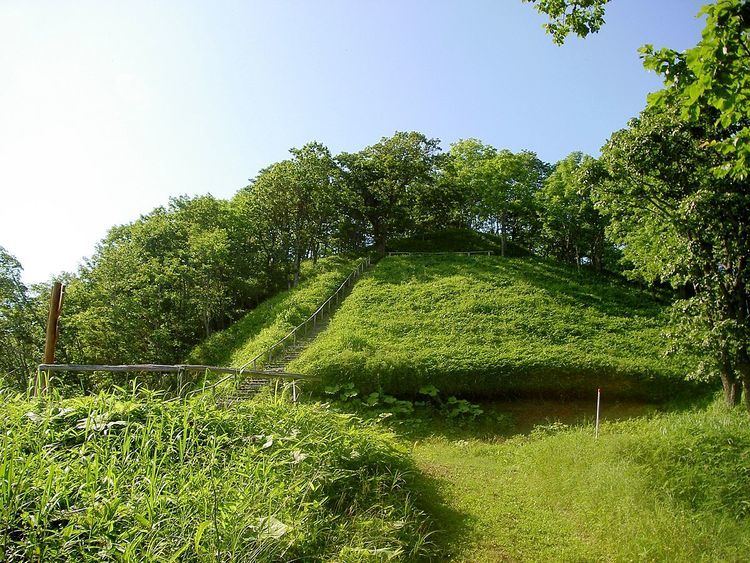 | ||
Chashi (チャシ also 砦) is the Japanese term for the hilltop fortifications of the Ainu. The word is of Ainu origin, from casi, which means palisade or palisaded compound; a rival theory relates the term to cas. Over 520 chashi have been identified in Hokkaidō, mostly in the eastern regions of the island; others are known from southern Sakhalin and the Kurils; similar phenomena such as the ostrogu of Kamchatka and the gorodische of northeast Asia may have developed independently. A few, including the Tōya casi of present-day Kushiro, date to the Muromachi period; the remainder date largely to the early seventeenth century. As such their construction may be related to increased competition for resources as a result of "intensification of trade" with the Japanese.
Contents
Form
The early Dutch explorer Maarten Gerritsz Vries described the chashi he encountered in eastern Hokkaidō in 1643:
These forts were made as follows: on the mountain on which they were placed was a small road steep to climb, and round on the four sides palisades were placed of the height … of 1½ man's length; within this stood two or three houses. There were large fir doors in the palisades with strong clamps; when they were closed, two stout bars were passed through the clamps and thus fastened to them. At the two corners of these … palisades, a high scaffolding is made of fir planks, for a lookout.
Shakushain's Revolt
The Ezo hōki (蝦夷蜂起, Ezo Uprising) and Tsugaru ittōshi (津軽一統志, Tsugaru Unification Record) recount the internecine conflict of 1668/9, which culminated in massacres of the Japanese, military intervention, and subjugation, in what is known as Shakushain's Revolt. According to the Ezo hōki, regional influence among the Ainu was based on "good land", "many utensils", charismatic authority, and physical strength. In 1668, disputes over deer, bear cubs, and a live crane lead to the Hae elder Chikunashi and his mother burning down the Shibuchari casi and killing the escapees. In response Shakushain sent the Urakawa Ainu to attack the Atsubetsu casi; driven off by musket fire they returned in force and captured it, after many of its defenders had left in search of food. The conflict escalated the following year into fighting with the Japanese; after his final surrender, Shukushain was killed and the Shibuchari casi again burned to the ground.
Known chashi
Among the approximately five hundred and thirty chashi identified by archaeologists, the sites of eight have been designated national Historic Sites: the Otafunbe chashi; Shibechari River chashi and Appetsu chashi; Moshiriya chashi; Yukuepira chashi; Katsuragaoka chashi; Nemuro Peninsula chashi; and Tsurugataicharanke chashi. Others known include the Arashiyama casi, Harutoru casi, Onibishi's casi, Sarushina casi, Sashirui casi, Setanai casi, and Uraike casi. Although there are nineteen chashi on the Shiretoko Peninsula, it is inscribed as a Natural rather than a mixed Natural and Cultural UNESCO World Heritage Site.
Functions
In addition to providing for defence against rival Ainu, chashi functioned as centres for gatherings and rituals. They also served as "visible symbols of chiefdom power". According to narrative uepeker or folktales, Akkeshi and Nemuro Ainu attacked the Uraike casi in the hope of "fine treasure"; other chashi were attacked by hungry Ainu looking for venison and dried salmon.
